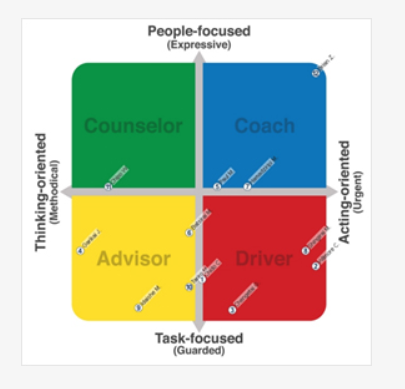PD Training (PDT) has been training adults for the past 10 years, so we have quite a bit of experience in assessing the actual knowledge transfer that occurs when participants attend our public or inhouse professional development training sessions.
In fact, we make it a point to ask that question as part of the feedback data we collect from both participants and those who actually booked the courses as well.
You can read a previous article, where we describe the process of continuous improvement that we have achieved during the last 10 years; improving our feedback scores from low 8’s out of 10 to mid 9’s out of 10.
The lessons we learned over the years, related to how different people learn and process new skills, came about as we developed and implemented the REACH Ecosystem, which usually begins for most participants by completing a short personality profile survey.
After completing the personality survey, the data is collated and displayed on a 2 x 2 grid which depicts the four primary types of personalities; which are Counselor, Coach, Advisor and Driver.

Now there are two ways to measure how an individual is placed on the grid:
- In which quadrant are they placed?
- How far are they placed away from the centre axis?
So, considering the examples above, individuals who are placed towards the outer edge of the graph are more extreme in their personality type, and people who are placed closer to where the quadrants touch the other quadrants are less extreme in their personality type.
The purpose of the REACH Ecosystem is not only to identify which quadrant an individual is placed, but to measure how easy is it for them to ‘reach’ into another quadrant and alter their personality type to meet and/or match another personality type.
But for the purpose of this article, we are more concerned with how each personality type learns and not so much how flexible these individuals are in their specific type.
In future we will create some deep dive articles that explain each personality type more in depth, but suffice to say, the four personality types actually prefer to learn by being exposed to different types of training experiences simply based on how they prefer to experience the world.
There is also a direct and absolute spill-over effect as to how these four different personality types prefer to do their work as well, but more on that in a future article.
Back to the 2×2 grid, by studying the grey arrows on the axis, and looking top to bottom and side to side, you will see the ranges that are identified within each personality type. From the top to the bottom, we go from People Focussed (Expressive) to Task Focussed (Guarded) and from side to side we range from Thinking Oriented (Methodical) to Action Oriented (Urgent).
Before we go further, it is important to point out that there is no good or bad with regards to where an individual is placed on the graph. In fact, our experience shows that the most healthy and productive teams have representatives from all four quadrants as each personality type brings a different skill and work preference to the team.
So, if we sit back and just think about the 4 quadrant’s names for a moment, and then assign a level of preferences to each personality type, we can see that an extreme driver would probably prefer to work alone (Guarded) and get things done asap (Task-Focussed) without much planning.
Where an extreme counsellor would prefer to think things through (Methodical), and work with others when doing so by being “Expressive”, but may avoid taking action unless prompted.
A extreme coach would have an “urgent” desire to help others achieve their goals (People-focussed) and an extreme advisor would prefer to work alone or in small groups to “plan” things out (Methodical) before taking any action (Task-Focussed).
By having self-awareness of where you are placed on the grid, and some external awareness of where others are placed on the grid, it makes absolute sense that these different types of individuals would also prefer to learn in completely different ways.
In fact, the preferences as to how these 4 types learn are so great, that PDT actually developed a Trainer’s Companion,  that is produced for the trainer, before the course is delivered and after all participants have completed their surveys.
that is produced for the trainer, before the course is delivered and after all participants have completed their surveys.
This Trainer’s Companion gives the trainer not only insights into the types of personalities in the room on the day, but also gives the trainer specific suggestions as to how to interact with the various personality types during the course and which types of activities each personality type prefers to be involved with in a training scenario.
We use a proven methodology to deliver a better training solution!
Our follow-up surveys have shown that by implementing this process into our course delivery experience, the participant’s knowledge transfer improved by up to 50% compared to delivering courses with no awareness of personality types and no customised delivery methodology.
And of course our overall feedback scores improved as well.
You can view a whole series of articles, with supporting scientific statistics that prove our theory of improved knowledge transfer and improved productivity on the REACH Ecosystem website.
So, when considering professional development training or coaching, please understand that not all adults learn the same way and not all training companies have developed such a powerful set of tools to assist with improving real knowledge transfer.
Contact PDT on 1300 121 400 to learn more!
 1300 121 400
1300 121 400
 LOGIN
LOGIN

Comments are closed.